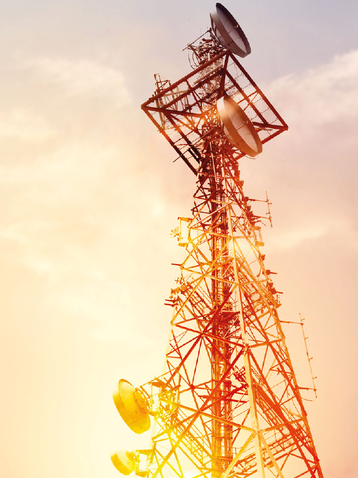While there is no replacement for the essential workers on the frontline, such as medical personnel, police, and government employees during this unprecedented time, there is a lesser-known and often unsung hero supporting our world through this time – the telecom industry, or, as I like to call it, the Unsung Atlas.
In Greek mythology, the word “Atlas” refers to a mythological character who is believed to carry the world on his shoulders. By definition alone, you might be able to see the reason for this chosen nickname; it certainly holds true for the telecom industry in the wake of Covid-19. The telecom industry is working in overdrive to keep up with the increase in network demands that has resulted from life during a pandemic, while also preparing for life after it. With most people working from home and finding entertainment and connection with family and friends online to prevent the spread of the virus, the connected world that the telecom industry is providing is crucial. Without it, our collective experience during this time could have been vastly different – both in access to information and connecting with each other – think about back to the Spanish Flu of 1918 when the world did not even have Radio broadcasting capabilities! Now do you appreciate Zoom meetings?
As one could probably guess, there has been a huge surge in network traffic – both voice & data, as the need to connect remotely with each other and our work has only increased. There has also been a shift in network traffic from business districts to residential areas as we all transitioned to working from home. For operators, those with capacity headroom or cloud-based core infrastructure that had access to software license augmentation to flex with capacity, managed well. However, Radio capacities, which by nature are limited by hardware, continued to be a challenge.
With the future so uncertain, we need to focus on what is certain – an altered approach to remote life. As remote working, learning, telemedicine, and other practices have become embraced by the masses, it’s unlikely we will ever revert all the way back to early 2020.
What we’ve learned
One of the biggest, non-technological benefits we’ve seen is that telecom stocks stood rock solid when most others crumbled within the stock market. Why? Because the industry is playing offense; it is playing a game of the future and is adapting to change like an experienced species that refuses to become extinct.
This crisis provided learnings, and presented even more opportunities. The telecom industry now has a unique opportunity to build on current capabilities that create value for consumers, operators and suppliers, and the following capabilities are critical for enabling this:
Increase capacity dynamically
To account for increased network capacity demands, virtualization of the core network is a necessity. In addition, operators should implement a common telco cloud infrastructure layer for all the Virtualized Network Functions (VNFs) rather than vertically integrated VNFs. Today, since most virtualization is vertically integrated and does not share the common infrastructure layer, networks are unable to dynamically use available capacity – a downfall in resource utilization.
Manage networks remotely
A great amount of value can be added when operators can remotely manage and deploy Radio or Fixed Networks. Implementations of SON (mobile) or Home device management and analytics (fixed) have already been proven to help operators better adapt and optimize their networks remotely.
End-to-end Security
Remote management of a network also includes end-to-end security. Operators need to select or implement security measures that make plugging vulnerabilities and granting access to only authorized personnel seamless. This becomes vital to ensuring success – in consumer confidence, operating costs, and data security.
Upcoming opportunities
In the not-so-distant future, it will be vital for the industry to act quickly once again as we are able to return to life in the “the new normal,” which is expected to include an unprecedented number of people working from home (WFH). Here, the upcoming opportunities include:
- Fixed Wireless Access –Residential areas will require more capacity and coverage – the most straightforward way to provide this is to deploy Fixed Wireless Access (FWA) on 5G where possible, and on 4G where not. In the case of 5G deployments, FWA can be immediately leveraged via the recently launched 5G spectrum.
- Enterprise Work From Home – Tata Consultancy Services (TCS), a global leader in IT services, consulting and business solutions, recently announced that 75% of their 450,000 employees will work from home by 2025. In the “new normal” most enterprises, large and small, will move to WFH for a majority of their people, which presents an enormous opportunity for operators to offer enhanced SDWAN, remote management and security services to these customers.
- IoT – Remote Infrastructure Management – With the anticipation that field manpower and essential service workers will be available only at a premium, there will be an influx in demand for remote management of all government, municipal and enterprise infrastructure, along with an increased demand for video surveillance. If the word “surveillance” makes you think twice about remote management of infrastructure, rest-assured that on an individual level, no access for meter readings – such as gas, electricity and water – inside homes will be likely. In this scenario, IoT (Internet of Things), which has always held big potential, can now be taken advantage of fully with the integration of mass IoT platforms and end point security.
A drastic change in end user behavior, coupled with new expectations from enterprise, will accelerate the widespread adoption of certain technologies. For operators this could mean a chance to see returns on their 5G investments sooner than anticipated.
Once we are in the “new normal,” a new digital era with augmented reality (AR) and virtual reality (VR) will transform the current paradigm, impacting all facets of life – everything from education and business meetings to tourism and sporting events. An added result of the pandemic, was that is exposed flaws to the global supply chain, and countries will be expected to encourage local manufacturers to avoid future supply chain disruptions that occurred during this crisis. In order to monetize these opportunities, the network will need to utilize successful use case based-5G deployments and require the following capabilities:
- Self-Service Customer Portal
- Flexible Charging capabilities
- End to End Service Orchestration
- End to End security
- Assurance / Analytics Capabilities - service lifecycle management
- Network Slicing / Network Exposure capabilities – for B2B services & Industry 4.0
To ensure effective implementation, customers will need to be able to schedule and pre-purchase their immersive experience – whether it be meetings, a gaming experience or AR/VR-based tourism experience – in an intuitive and simple interface, just like they experience when buying event tickets today. To accommodate capacity and demand, each of these events will require specific bandwidth and latency, along with reliable service orchestration that is capable of creating the slice on the fly for the required duration of the experience, continuously monitor it for vulnerabilities and performance issues, and delivering the analytics required. Policy and charging capabilities that can bill the customers are key to enable monetization, and end-to-end security will also be paramount for such an open architecture.
The telecom industry is not only a central piece of modern-day life, it is essential, both during these times and in the future. By definition, an “atlas” can also be defined as a book of maps. By this definition, the telecom industry has the opportunity to lead the way forward – our unsung atlas.


